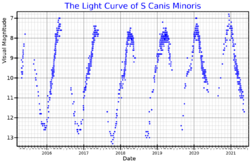Astronomy:S Canis Minoris
| Observation data Equinox J2000.0]] (ICRS) | |
|---|---|
| Constellation | Canis Minor |
| Right ascension | 07h 32m 43.06942s[2] |
| Declination | 08° 19′ 05.1975″[3] |
| Apparent magnitude (V) | 6.5 to 13.7[4] |
| Characteristics | |
| Evolutionary stage | AGB[5] |
| Spectral type | M7-8e[6] |
| B−V color index | 1.50±0.51[7] |
| Variable type | Mira[8][4] |
| Astrometry | |
| Radial velocity (Rv) | 68.0±4.8[9] km/s |
| Proper motion (μ) | RA: −10.785[2] mas/yr Dec.: −12.827[2] mas/yr |
| Parallax (π) | 2.3934 ± 0.0982[2] mas |
| Distance | 1,360 ± 60 ly (420 ± 20 pc) |
| Details | |
| Mass | 4.5[10] M☉ |
| Radius | 710[11] R☉ |
| Luminosity | 6,493[12] L☉ |
| Surface gravity (log g) | −0.55[10] cgs |
| Temperature | 2,813[10] K |
| Metallicity [Fe/H] | +0.39[10] dex |
| Other designations | |
| Database references | |
| SIMBAD | data |
S Canis Minoris is a variable star in the equatorial constellation Canis Minor. It has a peak apparent visual magnitude of 6.5, so not normally visible to the naked eye. The star is located at a distance of approximately 1,360 light-years from the Sun based on stellar parallax, and is drifting further away with a radial velocity of about +68 km/s.
This is an aging red giant star with a stellar classification of M7-8e,[6] where the 'e' suffix indicates emission lines in the spectrum. It is a Mira-type[8] long period variable that varies by an amplitude of 4.27 in visual magnitude over a period of 327.77±2.78 d.[14] Evidence has been found of asymmetry in this star, suggesting a non-spherical shape.[5] Abundance-wise, it is an oxygen-rich[12] giant and the emission feature is of the oxygen-rich silicate class as it sheds silicate dust from its atmosphere.[15] The star is shedding mass at the rate of 4.9×10−8 M☉·yr−1.[5]
References
- ↑ "Download Data". AAVSO. https://www.aavso.org/data-download.
- ↑ 2.0 2.1 2.2 2.3 Vallenari, A. et al. (2022). "Gaia Data Release 3. Summary of the content and survey properties". Astronomy & Astrophysics. doi:10.1051/0004-6361/202243940 Gaia DR3 record for this source at VizieR.
- ↑ Brown, A. G. A. (August 2018). "Gaia Data Release 2: Summary of the contents and survey properties". Astronomy & Astrophysics 616: A1. doi:10.1051/0004-6361/201833051. Bibcode: 2018A&A...616A...1G. Gaia DR2 record for this source at VizieR.
- ↑ 4.0 4.1 Samus, N. N. et al. (2017). "General Catalogue of Variable Stars". Astronomy Reports. 5.1 61 (1): 80–88. doi:10.1134/S1063772917010085. Bibcode: 2017ARep...61...80S.
- ↑ 5.0 5.1 5.2 Danilovich, T. et al. (September 2015). "New observations and models of circumstellar CO line emission of AGB stars in the Herschel SUCCESS programme". Astronomy & Astrophysics 581: 33. doi:10.1051/0004-6361/201526705. A60. Bibcode: 2015A&A...581A..60D.
- ↑ 6.0 6.1 Keenan, Philip C. et al. (1974). "Revised Catalog of Spectra of Mira Variables of Types ME and Se". The Astrophysical Journal Supplement Series 28: 271. doi:10.1086/190318. Bibcode: 1974ApJS...28..271K.
- ↑ Anderson, E.; Francis, Ch. (2012). "XHIP: An extended hipparcos compilation". Astronomy Letters 38 (5): 331. doi:10.1134/S1063773712050015. Bibcode: 2012AstL...38..331A.
- ↑ 8.0 8.1 Garfinkle, Robert A. (1997). Star-hopping: your Visa to Viewing the Universe. Cambridge, United Kingdom: Cambridge University Press. pp. 78–81. ISBN 978-0-521-59889-7.
- ↑ Gontcharov, G. A. (November 2006). "Pulkovo Compilation of Radial Velocities for 35495 Hipparcos stars in a common system". Astronomy Letters 32 (11): 759–771. doi:10.1134/S1063773706110065. Bibcode: 2006AstL...32..759G.
- ↑ 10.0 10.1 10.2 10.3 Anders, F.; Khalatyan, A.; Queiroz, A. B. A.; Chiappini, C.; Ardevol, J.; Casamiquela, L.; Figueras, F.; Jimenez-Arranz, O. et al. (2022). "VizieR Online Data Catalog: StarHorse2, Gaia EDR3 photo-astrometric distances (Anders+, 2022)". Vizier Online Data Catalog. Bibcode: 2022yCat.1354....0A.
- ↑ Kervella, Pierre; Arenou, Frédéric; Thévenin, Frédéric (2022). "Stellar and substellar companions from Gaia EDR3". Astronomy & Astrophysics 657: A7. doi:10.1051/0004-6361/202142146. ISSN 0004-6361. Bibcode: 2022A&A...657A...7K.
- ↑ 12.0 12.1 Winters, J. M. et al. (October 2003). "Mass-loss from dusty, low outflow-velocity AGB stars. I. Wind structure and mass-loss rates". Astronomy and Astrophysics 409 (2): 715–735. doi:10.1051/0004-6361:20031110. Bibcode: 2003A&A...409..715W.
- ↑ "S CMi". SIMBAD. Centre de données astronomiques de Strasbourg. http://simbad.u-strasbg.fr/simbad/sim-basic?Ident=S+CMi.
- ↑ Vogt, N.; Contreras-Quijada, A.; Fuentes-Morales, I.; Vogt-Geisse, S.; Arcos, C.; Abarca, C.; Agurto-Gangas, C.; Caviedes, M. et al. (November 2016). "Determination of Pulsation Periods and Other Parameters of 2875 Stars Classified as MIRA in the All Sky Automated Survey (ASAS)". The Astrophysical Journal Supplement Series 227 (1): 13. doi:10.3847/0067-0049/227/1/6. 6. Bibcode: 2016ApJS..227....6V.
- ↑ Sloan, G. C.; Price, S. D. (December 1998). "The Infrared Spectral Classification of Oxygen-rich Dust Shells". The Astrophysical Journal Supplement Series 119 (2): 141–158. doi:10.1086/313156. Bibcode: 1998ApJS..119..141S.
 |


